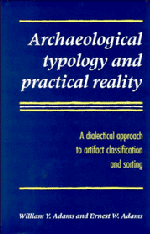 Archaeological Typology and Practical Reality
Archaeological Typology and Practical Reality Book contents
- Frontmatter
- Contents
- List of figures
- List of tables
- The archaeologist's preface
- The philosopher's preface
- PART I Introductory
- 1 Beginning points
- 2 Introductory theses
- PART II The nature of types and typologies
- PART III Typology in action: the Medieval Nubian Pottery Typology
- PART IV Pragmatics of archaeological typology
- PART V Classification, explanation, and theory
- Appendices
- References
- Index
1 - Beginning points
Published online by Cambridge University Press: 23 November 2009
- Frontmatter
- Contents
- List of figures
- List of tables
- The archaeologist's preface
- The philosopher's preface
- PART I Introductory
- 1 Beginning points
- 2 Introductory theses
- PART II The nature of types and typologies
- PART III Typology in action: the Medieval Nubian Pottery Typology
- PART IV Pragmatics of archaeological typology
- PART V Classification, explanation, and theory
- Appendices
- References
- Index
Summary
On a summer afternoon in 1983, two brothers – the authors of this book – went for a hike in the California mountains. As usual on the infrequent occasions when we get together, our conversation ranged over matters of common intellectual concern. On this particular afternoon we somehow got onto the topic of scientific typologies, and we discovered for the first time that we share a strong interest and closely similar views on the subject, although approaching it from nearly opposite directions.
Ernest W. Adams (hereinafter EWA) is Professor of the Philosophy of Science at Berkeley. Earlier work in the field of scientific measurement (EWA 1966; Adams and Carlstrom 1979) had led him, by natural extension, to a consideration of typologies, which have some of the attributes of measurement (see Chapter 7). William Y. Adams (hereinafter WYA) is Professor of Anthropology at the University of Kentucky, and for many years has also been a director of archaeological excavations in Egypt and the Sudan. The practical requirements of his work have led him over the years to construct a number of typologies (WYA 1962d; 1964a; 1965a), the best known of which is a classification of medieval Nubian pottery wares (WYA 1986a). This has become the principal instrument for calculating dates of occupation at Nubian archaeological sites, and has been adopted for that purpose by a number of different expeditions (see Gardberg 1970; Scanlon 1970; Säve-Söderbergh 1981).
- Type
- Chapter
- Information
- Archaeological Typology and Practical RealityA Dialectical Approach to Artifact Classification and Sorting, pp. 3 - 17Publisher: Cambridge University PressPrint publication year: 1991
